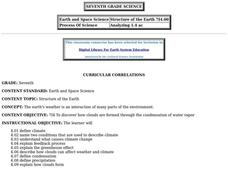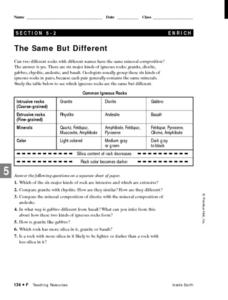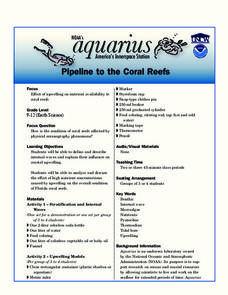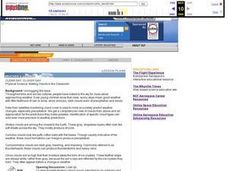Curated OER
Water Density Boundaries
Young scholars create observable layers in water that represent a separation based upon density differences. They model density boundaries using differences in temperature and salinity. They, in groups, perform a meaningful experiment...
Curated OER
Let's Make a Cloud
Students watch the teacher make a cloud. In this water cycle instructional activity, students discuss the water cycle and see the formation of a cloud. The teacher leads the discussion including the role of water vapor, smoke and air...
Curated OER
What happens When Air is Heated or Cooled?
For this pressure worksheet, students write down their observations of a can placed into hot water. They explain what happens to the air molecules and the pressure inside the bottle which causes it to collapse.
Curated OER
What Happens When Air is Heater or Cooled?
In this air pressure learning exercise, students use a can to demonstrate how air pressure collapses a can when placed in hot water.
Curated OER
How Does a Thermometer Work?
Pupils explore how a thermometer works. In this temperature lesson, students use a glass bottle, a straw, and food coloring to construct a homemade thermometer. Pupils record observations.
Curated OER
Weather
Students participate in a variety of mini-lessons including experiments, literature readings, physical education components, music, data gathering and recording and more to expose them to several themes of weather; i.e. water cycle,...
Curated OER
What's the Difference Between Concentration and Solubility?
Young scholars discuss the difference between concentration and solubility as well as examine the difference in a hands-on activity. Using water and table salt, they experiment with solubility. They create different concentrations using...
Curated OER
Driving Currents
Students conduct a variety of investigations to see how water, heat, and salinity affect the flow of the world's ocean currents,as well as, explore many factors that affect the flow of the world's ocean currents. They also describe in...
Curated OER
Structure of the Earth
Seventh graders study the cause of climate change, and how clouds form and affect weather. They define condensation and precipitation, the greenhouse effect and the water cycle.
Curated OER
The Open Ocean, What is it and How Does it Change?
Students investigate the ocean environment. For this ocean lesson, students discover the physical properties of the ocean. Over two days, students work in small groups investigating ocean maps and creating water currents.
Curated OER
Winter Insulation
Learners test insulation materials. In this energy conservation lesson, students use different insulation materials to see which one holds heat the best. Learners pour hot water into bottles, take the temperature, wait 15 minutes, then...
Curated OER
Air Density and Temperature
Young scholars investigate the effect of temperature on the density of air by putting an uncovered bottle in a bucket of hot water. Then they place a balloon over the mouth of the bottle. They repeat the procedure using ice water and...
Curated OER
The Same, But Different
Third graders examine the phase change between solids and liquids and determine it to be a physical change. Ice is the perfect item to use to demonstrate this phase change. Pupils experiment with measuring and weighing solid ice and the...
Colorado State University
Why Do Raindrops Sometimes Land Gently and Sometimes with a Splat?
A mouse can fall from large heights without injury! Air resistance is a large influence on small falling objects. In an exploratory lesson, young scholars build a raindrop bottle to compare the falling rate of different-sized objects.
NOAA
Microfriends
Is there medicine found in the organisms that live deep below the surface of the ocean? The fifth lesson in a six-part series has learners team up to research bacteria and the relationship it has with nearly every living thing on Earth....
Curated OER
Liquid Pressure
Fifth graders create a Cartesian Diver model made from plastic soap bottle and medicine dropper. In this incompressible liquid lesson, 5th graders experiment with jugs of water to demonstrate Pascal's Law, Boyle's Law and Archimedes'...
NorthEast Ohio Geoscience Education Outreach
Investigation of Plate Boundaries
Demonstrate the movement of lithospheric plates due to convection in Earth's mantle. Learners then model the movements that occur along plate boundaries using colored clay.
Carnegie Mellon University
Introduction to Climate
Begin a full lesson on climate change by demonstrating how carbon dioxide gas contributes to increased temperatures. Be aware that pressure inside the antacid-containing bottle in Activity 2 may cause the lid to fly off; keep viewers at...
Florida International University
Pipeline to the Coral Reefs
Discover firsthand the effects of internal waves on coral reefs. Through a series of experiments, learners simulate internal waves and upwelling events as they make observations on the movement of water and other debris. They then...
Curated OER
A Very Simple Conductivity Meter
Learners conduct a simple conductivity meter to test the ionic or non-ionic nature of water samples including one from their home.
Curated OER
Make a thermometer
In this thermometer worksheet, students make a thermometer out of a straw, juice bottle, food coloring and more. Students also answer 3 questions about it.
Curated OER
Clear Day, Cloudy Day; Weather, Cloud Types and Formations
Learners explore the formation of clouds and different cloud types. Students simulate a cloud formation within a bottle.
Polar Trec
Sea Ice Impact
The arctic seas contain currents that are both warm (with high salinity) and cold (relatively fresh water) that circulate throughout the year. Through discussion, a lab, and a web quest, participants explore the impacts of melting and...
Curated OER
Activity #17 Liquid Density and Temperature
Students comprehend that hot water rises up through cold water but cold water does not rixe in hot water. They comprehend that water at temperatures above 4oC decreases in density with increases in temperature. Students answer lab...

























